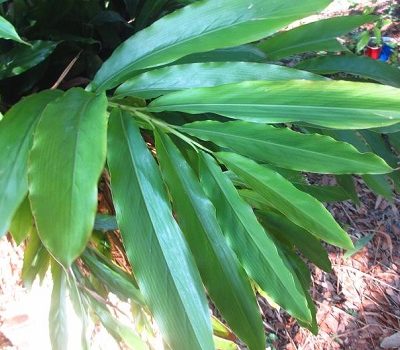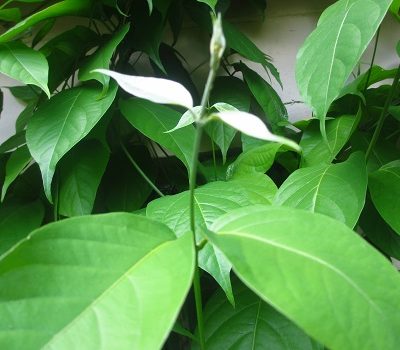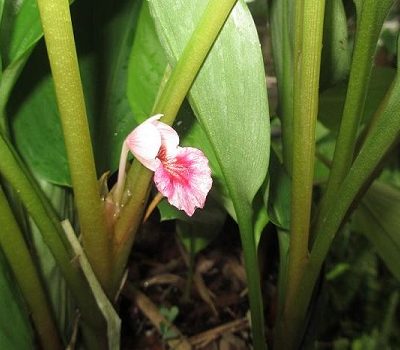You can’t talk about tropical fruiting plants without talking about pineapple plants. Most people are very familiar with the fruit, but unfamiliar with the plant that grows it.
Do Pineapples Grow On Trees?
Do pineapples grow on trees? No, they do not, but many people mistakenly think that they do. Pineapple plants are in the family bromeliaceae, along with Tillandsias, and many other ornamental rosette forming plants. Although not the largest, they are quite large for bromeliads, with long pointy leaves that can be over three feet long. An adult pineapple plant will eventually produce an inflorescence from the center of the rosette. This is a compound flower, which eventually develops into a compound fruit. That is to say, the fruit is actually made up of many smaller fruits that are fused into one, juicy, delicious, pineapple. Pineapples grown at home, and allowed to completely ripen on the plant before harvesting them, are vastly superior to grocery store fruit in both flavor and sweetness. They can be just as big too, if you know how to grow them properly.
Growing Pineapples
I have been growing pineapples for twenty, with great success. I have produced hundreds of plants over the years, that are all clones of the one original crown that I started with. I don’t sell pineapple plants, but I tell anyone who wants to listen to me, how they can easily grow their own.
Warning: Before I say anything else about this topic, I just wanted to warn you against buying pineapple plants from the garden departments of the big box stores. These little plants usually have a very small pineapple growing from them, but they aren’t the same variety that grow the big tasty fruit that you and I know and love. It makes me very angry that they deceive people with these little dwarf pineapple plants, which cost six or seven dollars a piece. Why buy those when you can buy a pineapple from the grocery store for four dollars, and you get to eat the fruit as well as growing a new plant that will grow big fruit. All you need is the information that I provide here.
Growing pineapples at home is actually very easy. If you live in a tropical or subtropical climate you can grow them in your backyard in a bright, sunny, location. If you live in zone 8 or lower, you’ll need to give them protection from the cold in the Winter. I know people that are growing them as houseplants in front of bright south facing windows, as far North as Canada, and Austria. Here in Florida, I leave them outside all year long. In a cold snap, I’ll throw a sheet over them, and they make it through just fine. I have also simply placed them up against my house, and left them outside in freezing temperatures, without covering them, and they weren’t damaged at all.
There are a great many websites and Youtube videos describing how to grow a pineapple plant from the crown of a fruit purchased from a grocery store. Most of them over think the process. Here is how I do it.
Obtaining A Pineapple Plant
First, it is best to do this in Spring or Summer when temperatures are warmer. The most important thing to keep in mind when choosing your pineapple at the grocery store, is to make sure that the crown of the pineapple looks as healthy as possible. If they are withered and dry, they may not grow.
Removing The Crown
Once you have your pineapple, grasp the crown at its base, and snap it off with a sideways movement. Do not cut it off, or there will be some fruit left below the crown, and that can rot the whole plant once you put it in soil.
Trimming The Crown
Next, you need to remove the smaller leaves from the base of the crown. These will peel off easily, one by one. Be fairly liberal while removing the leaves until you have over an inch of the core of the crown exposed. When in doubt, peel a few more leaves off. If you leave too many leaves on it, there won’t be enough core exposed to grow the roots that the plant needs to supply the leaves with water.
Planting The Crown
Now all you have to do is plant your crown in potting soil, making sure that the exposed core is completely buried in the soil, and make sure that the soil stays moist, but not damp. It should grow roots within a week or two at the most. Many people root them by putting them in a glass of water. This is unnecessary, and the roots that grow will be damaged when you do finally plant them in soil.
So That’s It?
Nope. Of course, this is where most of the other sites end the discussion, but not here at Randy’s Tropical Plants. This is just the beginning. Without knowing what to do next, you’ll wait two or three years, and you’ll be rewarded for your efforts with a baseball sized fruit that is mostly core, with just a few bites of fruit. I’ve even had people insist to me that a baseball sized fruit is the best you can ever achieve in a container at home, but this is simply not true, and I have the video to prove it.
Here are the most important points to get your plant to successfully produce fruit.
Light
Pineapple plants need full sun or as close to full sun as you can provide. This is really important. A plant grown in shade will not produce well. Give them at least four hours of direct sunlight per day.
Container Size
Pineapple plants need a lot of root space. I grow all of my pineapples in containers, but this is mostly because they are susceptible to the root knot nematodes that are, unfortunately, ubiquitous here in Florida. I once thought that they need at least ten gallons of root space, and I even planted many of them in twenty gallon pots. This worked really well, but I have since then discovered that this was overkill. A 3-5 gallon container will suffice as long as you provide the necessary nutrients. Smaller than 3 gallons, and the fruit production will be negatively affected. If your climate is appropriate, and you don’t have root knot nematodes in your soil, then you should plant them in the ground.
Nutrients
Pineapple plants have some very specific nutrient requirements. Most notably is their need for iron. I use a dilute, liquid, chelated, iron supplement once a month during the warm months. I’ll usually also add a half of a gram or so per gallon, of magnesium sulfate (epsom salt) to the iron solution. I continue this throughout the life of the plant. If liquid chelated iron is not available, top dress the soil with a time release iron supplement every three months.
I prefer to provide macro-nutrients (ie N,P,K) weekly at 1/4 strength, rather than monthly at full strength. When a plant is in its first year, I use a fertilizer that is high in nitrogen to promote vegetative growth. All purpose Miracle Gro is a good choice. In its second year, I switch to a more balanced fertilizer. At this point, I like to use fertilizers that are formulated for tomatoes. Those have enough phosphorus to promote blooming, as well as the potassium needed for fruit growth.
Pineapple plants don’t go through a dormancy per se, but they don’t really grow much in the Winter. I withhold fertilizer during the Winter, but if you live in the tropics, pineapples will grow vigorously all year, and should be fed.
Harvesting The Pineapples
A common misconception about pineapples, is that they are harvested unripe and that they will develop sugars as they ripen. This is simply wrong. Pineapples produce the sugar in the base of the plant. The sugar is then pumped up the stalk into the pineapple. Once a pineapple is cut off of the plant, it is as sweet as it is ever going to be. It will continue to ripen, and the flavor will change as the fruit begins to ferment, but it will not get any sweeter. Growers harvest the fruit a bit early so that they will ship well, and have a longer shelf life, but they do this at the sacrifice of some sweetness and flavor. At home, you can wait until they are completely ripe. I harvest them when three quarters of the skin has turned yellow, and it begins to have a pineappley smell. Fruit harvested in this way will be so much sweeter and tastier than any store bought fruit, that you’ll hardly believe that the two are the same thing.
Caveat: once you’ve had this superior version of pineapple, it will ruin the regular store bought pineapple for you, for the rest of your life.
So What’s Next?
Once you harvest your pineapple, the rosette that grew it will no longer grow any more leaves or flowers. The plant is not, however, dead. You will undoubtedly want to grow the crown of the fruit that you just harvested, but the mother plant will continue to grow as well. Usually the new growth will come from between the older leaves. Often there will be several new growths. These are referred to as suckers. I leave the biggest strongest sucker on the plant to grow. I wait until the other suckers are big enough to grab with my hand, and I snap them off, just like you do with the crown on top of the pineapple. I then trim them and plant them just like a crown. In this way, your pineapple patch will grow very quickly. You’ll eventually find yourself having to give away the new young plants as you run out of space for them.
As well as the crown and the suckers, there are two other types of new growth. Ratoons are growths that come up through the soil from around the base of the plant. I always remove these and plant them in their own pot. The other type of new growth, grows from the base of the pineapple fruit, on the top of the stalk of the fruit. These are called slips. Slips are reported to cause the developing fruit to be smaller, but my plants rarely grow them. This is probably because most pineapples selected for large plantations, are varieties that don’t readily grow slips, and grocery store pineapple crowns are clones of those varieties.










I just want to tell you that I’m new to blogging and absolutely savored your website. Almost certainly I’m planning to bookmark your blog post . You actually come with very good well written articles. Thanks a bunch for sharing with us your web site.
I have an overcrowded container with pineapples that I planted approx 5 yrs ago and have propagated and produced for 3 years – Right-now I have 2 pineapples growing in the same container. How do I transplant into individual containers without damaging the plants?
This is kind of old, but they are pretty tough. You can simply un-pot them, split them up and repot them separately. They will recover pretty easily.
Really liked your article on Pineapple plants. We decided over a year ago to try growing one from the top of a pineapple we bought at the grocery store. Now we have the original plant and two others that sprouted from it. Pretty fun hobby. Being in Manitoba Canada I’m surprised they have survived, but they seem to be doing well.
Thanks! Good luck with your plants.
Hi Randy, Thanks for the detailed instructions on growing pineapples. I am at the North boundary of Palm Beach Cointy and want to grow them in the ground in a spot that gets full sun in the summer but a bit less in the winter when it is partially shaded by a building. There used to be a pineapple plantation here in Jupiter that used shade cloth over the plants. What do you think?
I think you should!